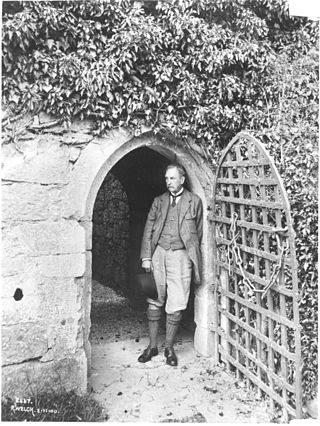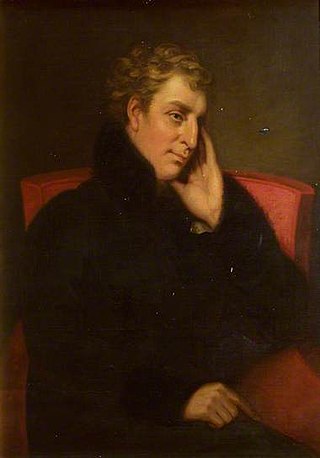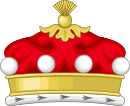
Duke of Atholl, named for Atholl in Scotland, is a title in the Peerage of Scotland held by the head of Clan Murray. It was created by Queen Anne in 1703 for John Murray, 2nd Marquess of Atholl, with a special remainder to the heir male of his father, the 1st Marquess.

Earl Ferrers is a title in the Peerage of Great Britain. It was created in 1711 for Robert Shirley, 14th Baron Ferrers of Chartley. The Shirley family descends from George Shirley of Astwell Castle, Northamptonshire. In 1611 he was created a Baronet, of Staunton Harold in the County of Leicester, in the Baronetage of England. He was succeeded by his son Henry, the second Baronet, who married Lady Dorothy Devereux, daughter of Robert Devereux, 2nd Earl of Essex. On the death of her brother Robert Devereux, 3rd Earl of Essex, she became the youngest co-heir to the baronies of Ferrers of Chartley and the barony of Bourchier, which had fallen into abeyance on the death of the third Earl. Shirley was succeeded by his eldest son, the third Baronet. He died unmarried and was succeeded by his younger brother, the fourth Baronet. He was imprisoned in the Tower of London by Cromwell and died there in 1656. On his death the title passed to his eldest son, the fifth Baronet. He died at an early age and was succeeded at birth by his posthumous son, the sixth Baronet.

Earl of Macclesfield is a title that has been created twice. The first creation came in the Peerage of England in 1679 in favour of the soldier and politician Charles Gerard, 1st Baron Gerard. He had already been created Baron Gerard, of Brandon in the County of Suffolk, in 1645, and was made Viscount Brandon, of Brandon in the County of Suffolk, at the same time as he was given the earldom. These titles are also in the Peerage of England. Lord Macclesfield was the great-grandson of the distinguished judge Sir Gilbert Gerard, Master of the Rolls from 1581 to 1594. He was succeeded by his eldest son, the second Earl. He was involved in the Rye House Plot of 1683, was sentenced to death but later pardoned by the King. On his death without legitimate issue in 1701 the titles passed to his younger brother, the third Earl. He had earlier represented Yarmouth, Lancaster and Lancashire in the House of Commons. When he died in 1702 the titles became extinct.

Lord Elibank, of Ettrick Forest in the County of Selkirk, is a title in the Peerage of Scotland. It was created in 1643 for Sir Patrick Murray, 1st Baronet, with remainder to his heirs male whatsoever. He had already been created a Baronet, of Elibank, in the Baronetage of Nova Scotia in 1628. His great-great-grandson, the fifth Lord, was an author and economist. He was succeeded by his younger brother, the sixth Lord, who was an admiral in the Royal Navy. On his death the titles passed to his nephew, the seventh Lord. He represented Peeblesshire in the House of Commons and also served as Lord Lieutenant of Peeblesshire.

Viscount Gage, of Castle Island in the County of Kerry of the Kingdom of Ireland, is a title in the Peerage of Ireland. It was created in 1720 for Thomas Gage, along with the subsidiary title of Baron Gage, of Castlebar in the County of Mayo, also in the Peerage of Ireland. In 1744 he also succeeded his cousin as eighth Baronet, of Firle Place. The titles remain united. The Gage family descends from John Gage, who was created a baronet, of Firle Place in the County of Sussex, in the Baronetage of England on 26 March 1622. His great-grandson, the seventh Baronet, represented Seaford in Parliament. He was succeeded by his first cousin, Thomas Gage, 1st Viscount Gage, the eighth Baronet. He sat as a Member of Parliament for Minehead and Tewkesbury and also served as Governor of Barbados. In 1720, 24 years before succeeding in the baronetcy, he was raised to the Peerage of Ireland as Baron Gage and Viscount Gage. His second son was the military commander the Hon. Thomas Gage.
Sir Gerald or Gerard Lally or O'Mullally was an Irish Jacobite and French military officer.

Baron Clonbrock, of Clonbrock in the County of Galway, was a title in the Peerage of Ireland. It was created on 3 June 1790 for Robert Dillon, who had earlier represented Lanesborough in the Irish House of Commons. His grandson, the third Baron, sat in the House of Lords as an Irish Representative Peer and served as Lord-Lieutenant of Galway. He was succeeded by his eldest son, the fourth Baron. He was also an Irish Representative Peer and Lord-Lieutenant of Galway. The title became extinct on the death of his son, the fifth Baron, on 1 November 1926.

Theobald Dillon, 7th Viscount Dillon of Costello-Gallin supported King James II, was attainted on 11 May 1691, and fell in the Battle of Aughrim during the Williamite War. His attainder was reversed in favour of the 8th Viscount on 20 June 1694.

Lucas Dillon, 6th Viscount Dillon was an Irish peer who recovered title and lands after the restoration of King Charles II.

Henry Dillon, 8th Viscount Dillon was an Irish soldier and politician. In 1689 he sat in the Patriot Parliament. He fought for the Jacobites during the Wiiliamite War, defending Galway against Ginkel and surrendering it in 1691 after a short siege. He obtained the reversal of his father's attainder in 1696 recovering his father's lands.

Charles Henry Dillon-Lee, 14th Viscount Dillon (1810–1865), was an Irish and English landowner. He lived in Ditchley, Oxfordshire, England, and was represented in Ireland by his agent Charles Strickland.

Charles Dillon-Lee, 12th Viscount Dillon, KP, PC (Ire) (1745–1813) conformed to the established religion in 1767.

Charles Dillon, 10th Viscount Dillon (1701–1741) fought in the War of the Polish Succession for France under Berwick as colonel-proprietor of Dillon's Regiment at the Siege of Kehl in 1733 and the Siege of Philippsburg in 1734. After the armistice, he married, moved to Ireland, and succeeded his cousin Richard as the 10th Viscount Dillon.

Henry Augustus Dillon-Lee, 13th Viscount Dillon (1777–1832), was an Irish politician, soldier and writer. Despite being a Protestant, he supported Catholic emancipation in Ireland and wrote on the topic. He sat as MP for Harwich in England in the last parliament of Great Britain and the first parliament of the United Kingdom. In the second parliament of the United Kingdom he sat for County Mayo in Ireland.

Thomas Dillon, 4th Viscount DillonPC (Ire) (1615–1673) held his title for 42 years that saw Strafford's administration, the Irish Rebellion of 1641, the Irish Confederate Wars and the Cromwellian Conquest of Ireland. He was a royalist and supported Strafford and Ormond. He sided with the Confederates for a while but was a moderate who opposed Rinuccini, the papal nuncio. Lord Dillon fled the field of the Battle of Dungan's Hill (1647) and did not rescue Ormond at the Battle of Rathmines (1649). However, he defended Athlone successfully against Ireton in 1650.

Theobald Dillon, 1st Viscount Dillon, was an Irish military commander and adventurer. He held extensive lands in eastern Connacht and north-western Leinster, some acquired by sharp practices. He was a loyal supporter of Elizabeth I of England in her Irish wars.

Henry Dillon, 11th Viscount Dillon (1705–1787) was an Irish peer and a soldier in French service. He was the colonel proprietor of Dillon's Regiment, an Irish regiment of foot in French service, in 1741–1744 and again in 1747–1767. In the War of the Polish Succession (1733–1735), he fought at the sieges of Kehl and Philippsburg. In the War of the Austrian Succession (1740–1748), he was present at the Battle of Dettingen in 1743, on the French side, while King George II was present on the English side.

Earl of Carrick, in the barony of Iffa and Offa East, County Tipperary, is a title in the Peerage of Ireland.
Arthur Dillon, Count Dillon (1670–1733) was a Jacobite soldier from Ireland who served as colonel of Dillon's Regiment in the Irish Brigade in French service. He fought in the Nine Years' War and in the War of the Spanish Succession where he excelled at the Battle of Cremona.
James Dillon, 1st Earl of Roscommon fought for the crown in the Nine Years' War. He was ennobled despite being a Catholic after his son Robert turned Protestant.














